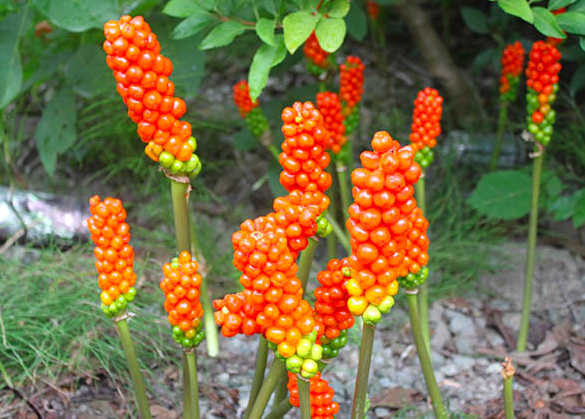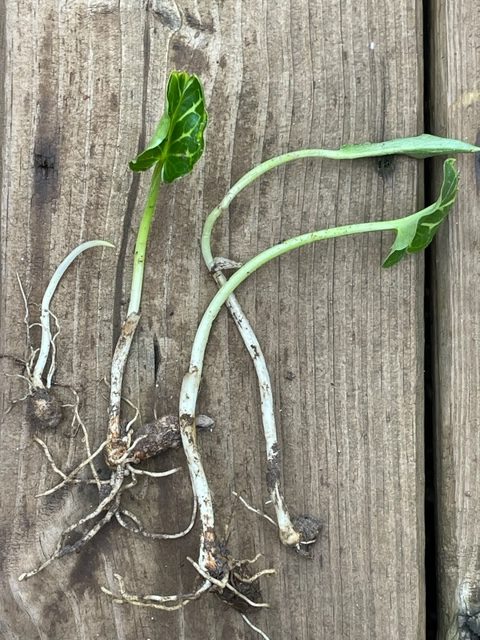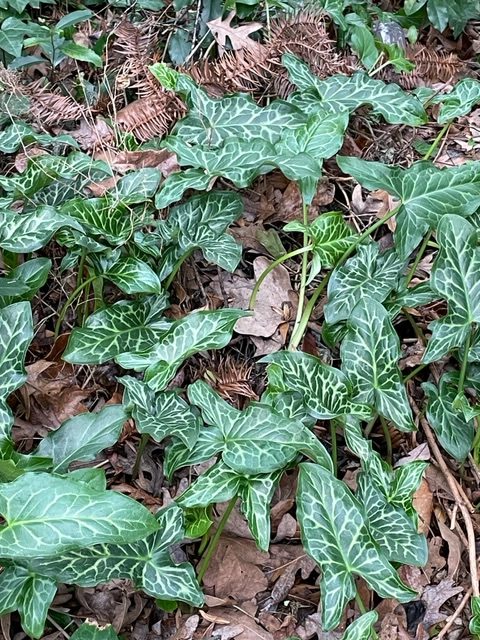When I moved to my home nineteen years ago, the garden looked quite different from the way it looks now. A large, grassy area was surrounded by some shrubs and lots and lots of English ivy.

As I began pulling out the ivy, I discovered many plants that had survived its strangle hold. Among these was Arum, a beautiful mottled green leaf that put out an interesting white spathe in spring and a terminal cluster of red berries in late summer. Obviously planted by some other gardener years ago, I was pleased and fascinated by this glossy leafed beauty. I carefully nurtured it, clearing away ivy and weeds to give it a good place to grow. And, I joyfully shared my bounty with friends, singing the praises of this beauty. (I’m sorry. I’m sorry!)
That was then. What I didn’t realize at that time was that arum, native to Europe and Asia, can become an incredibly invasive and persistent pest that is dastardly difficult to get rid of. It took about 17 years but one day I walked out and realized that things were out of control. I had a field of arum underneath my Mom’s maple tree and it was choking out everything else so I got to work.

First I just pulled at it by hand but the stems broke off at ground level. I reasoned that without leaves, the plant would soon die. Not so. Next I chopped at it with a hoe, reasoning that if the small corms were damaged they would not survive. Not so, they just multiplied.
The biggest problem is that the Arum corm is found about four inches deep and if you don’t dig down to get the entire bulb, the plant is just going to grow and multiply. You can’t just pull it up by hand, you have to dig. And, if you put your hard-earned bulbs and leaves in a compost pile, they’ll simply root and you have to start over again. In comparison, English ivy is easy to control.

To make matters worse, this plant euphemistically called Italian Lords and Ladies, is also poisonous, making it useless to wildlife and uncomfortable for gardener’s to touch. So as you’re digging and cursing to get rid to this royal pain in the neck, be sure to wear gloves.
I have to admit to being slightly obsessed with this white rooted monster. Even if I believed in using chemicals in the garden, which I vehemently do not, herbicides seem to have little effect. It just has to be dug and eliminated by hand. Whenever it’s not freezing cold or pouring down rain, I go out and dig up a few bulbs and place them in a plastic trash bag. I’m making progress but I’m far from being Arum – free.

You might ask why I don’t just leave them – they are attractive and really, what harm are they doing? And this is my answer: Any invasive plant reduces diversity in the landscape. And diversity leads to balance and balance leads to a healthy ecosystem. And health and balance are my primary gardening goals.
So, I’m staging a rebellion to overthrow the “Lords and Ladies” in my garden. Viva le jardin!
